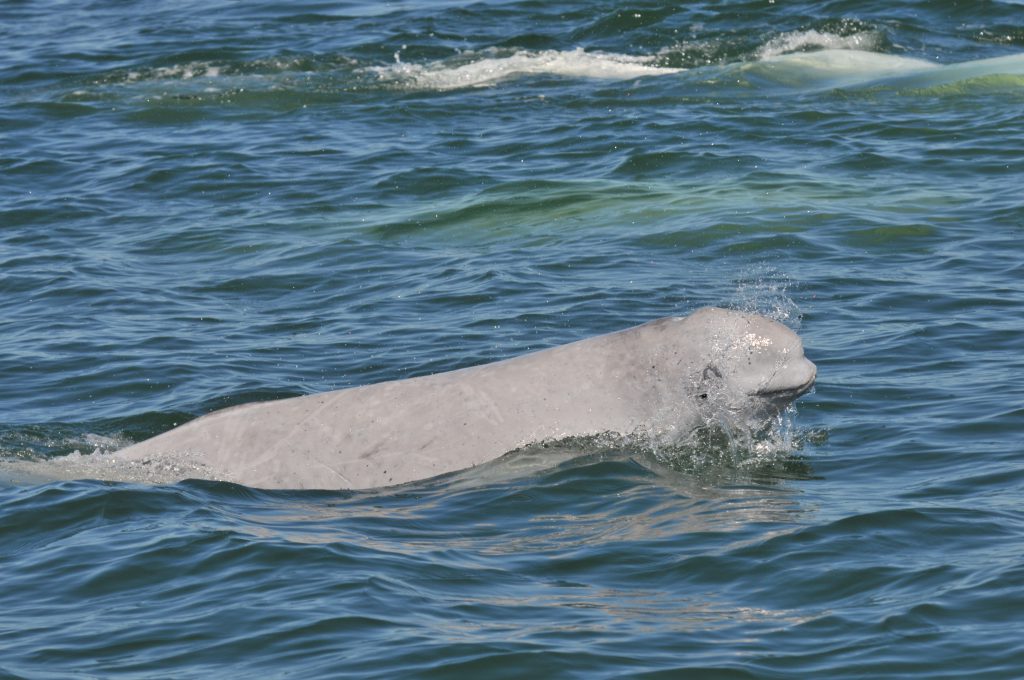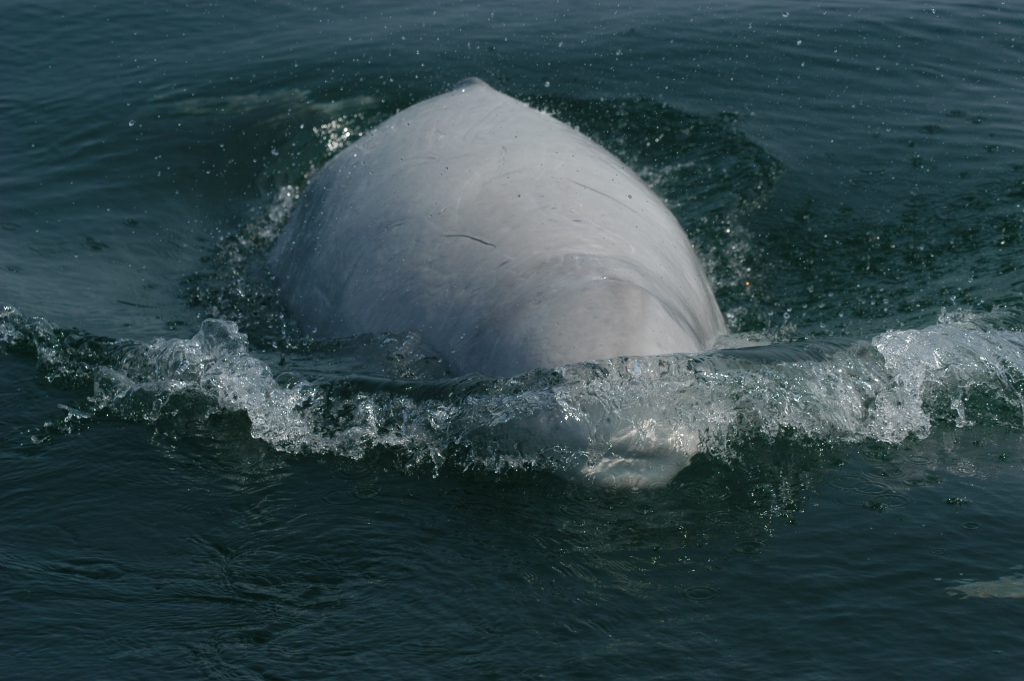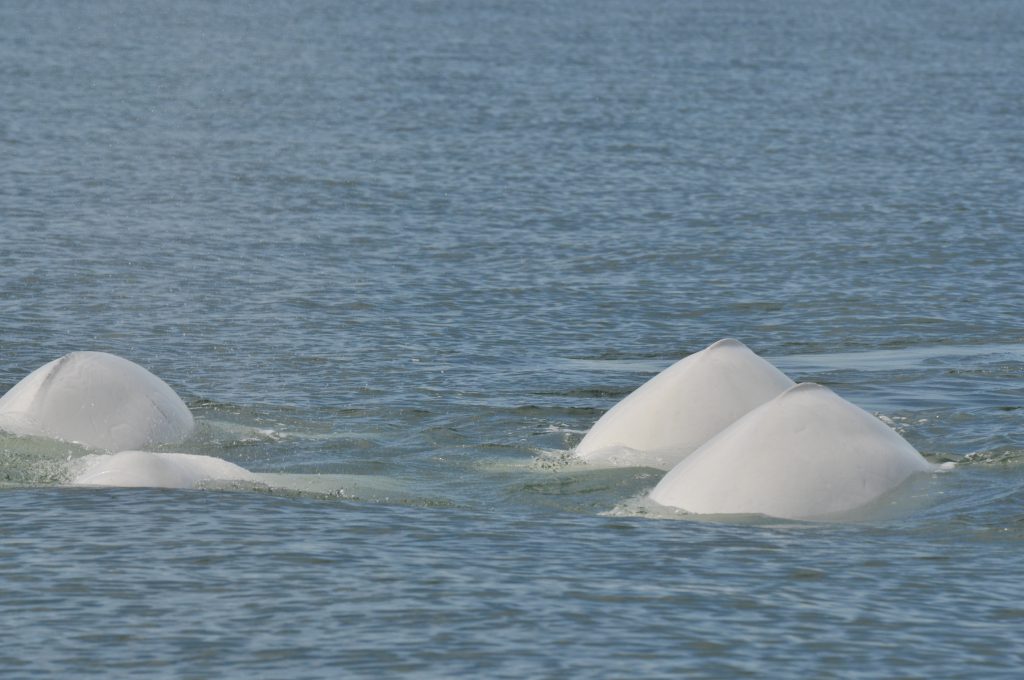By Bobby Mikelberg; Sea of Change Intern
We’re heading north for this edition of our popular “Creature Feature”, showcasing the fascinating beluga whale. The beluga whale (Delphinapterus leucas) is a relatively small cetacean sharing the order Monodontidae with another unique cetacean, the narwhal (Monodon monoceros). Belugas are well-known in popular culture as “canaries of the sea” for their frequent vocalizations and for the classic, whimsical children’s song, “Baby Beluga”. Their calves are born dark brown but quickly develop into a dark blue-grey tone before gradually becoming creamy white as adults. This all-white adult coloration differentiates it from all other whale species. Fully-grown adults can be as long as 5 meters (15 feet) and weigh up to 3,500 pounds. The adult males are slightly larger in size and weight than the adult females. The beluga pectoral fins are a relatively small for its body size, and they have a short dorsal ridge as opposed to a large dorsal fin. This less obtrusive dorsal feature facilitates maneuvering under sea ice as well as preventing heat loss in the cold arctic waters that are the primary habitat.

Beluga whales have a distinct, bulbous head. It is widely believed that the extensively developed head allows for effective sound production and echolocation. They can produce many different types of sounds in a wide range of frequencies reminiscent of bird songs. The sounds they emit are believed to depend on the type of activity an individual is engaged in such as feeding, socialization, or navigation.
As one of the few arctic cetacean species, beluga whales inhabit the cold northern oceans and estuaries in and along the Canadian, Russian, Alaskan and Greenland coasts. Sub-populations are typically migratory in nature, swimming at average speeds of 3-9km/h (2-6 mph) and reaching sprint speeds of up to 22km/h (14 mph), ranking them among the slowest of marine mammal swimmers. In the summer months, populations spend their time in small rivers and estuaries in search of prey rich feeding grounds while winter months brings thick ice to the surface of small waterways, forcing the animals north into deeper rivers and ocean water around the arctic sea ice.

Beluga whales are versatile and opportunistic predators. Their preferred food sources in deeper waters are cod, salmon, capelin, and herring though they have been found to feed on a wide variety of fish and even sometimes opt for invertebrates like shrimp, squid, and crabs when in shallower waters. As with many predatory whale species, they are susceptible to toxin bioaccumulation, as harmful contaminants store in fat and progressively accumulate all the way up the food chain. Beluga whales reach sexual maturity between the ages of 8 and 15 years, with gestation periods between 14-15 months and young nursing from their mothers for 1-2 years.
This species faces many biological and anthropogenic threats. In fact they share the colder northern waters with two bona fide apex predators in polar bears and killer whales. These species have been seen predating belugas. Additionally, belugas are susceptible to infectious diseases that may be exacerbated by pollution especially in populations that reside in human-influenced habitats. A high PCB (polychlorinated biphenyl, a once widely use organic human carcinogen) concentration in the St. Lawrence Estuary sub-population is believed to contribute to high mortality. Other threats include accidental by-catch and overfishing of their food sources. They are also vulnerable to boat strikes and noise pollution as mammals they must breath air and so they spend much of their time at the waters’ surface. The beluga is officially listed as a species of ‘Least Concern’ with global population estimates of 136,000 individuals according to the IUCN Red List. However, the Alaska Cook inlet population is categorized as critically endangered and three more sub-populations are categorized as endangered by the IUCN.

Despite their remote, northern habitats, we should keep this interesting species in mind when supporting conservation. There is a lot of work to do to protect beluga whales from shipping routes, oil spills, and noise pollution. Additionally, important research is being done to further understand their population dynamics and health risks. For example, the Beluga Whale Alliance aims to protect the critically endangered Cook Inlet population, and an open water sanctuary has recently been built in Iceland that has already received two individuals rescued from captivity in China. The World Wildlife Fund is also working to identify critical habitats in Canada and the arctic as well as promoting Inuit, scientist and governmental collaboration on industrial planning and climate change initiatives. You can learn more about this wonderful species at the links below; please support their conservation so that beluga whales can continue to sing well into the future.
List of Links with More Information about Belugas below:
https://www.worldwildlife.org/species/beluga
https://www.fisheries.noaa.gov/species/beluga-whale
https://www.mmc.gov/priority-topics/species-of-concern/cook-inlet-beluga-whale/
https://www.marinebio.org/species/beluga-whales/delphinapterus-leucas/




